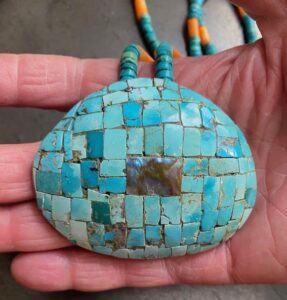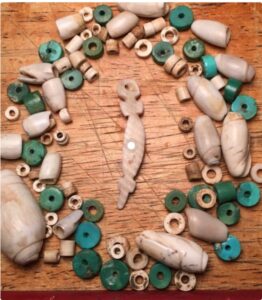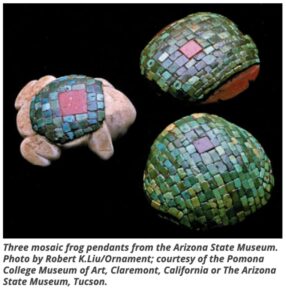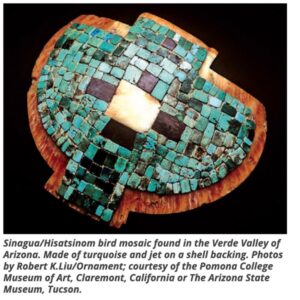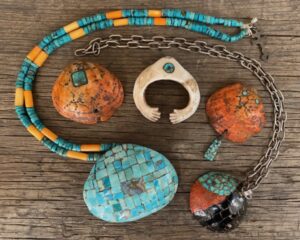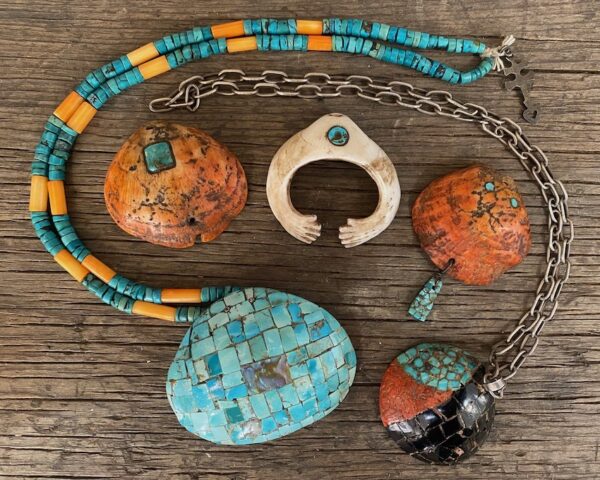
Shell As A Pueblo Ornament, From Prehistoric to Modern Times
- by Jamie Compton
- in A closer look... Gallery News New Gallery Item
- posted May 12, 2023
Prehistoric Pueblo Shell Ornamentation
Shells have been used for well over 2000 years in the Southwest by the ancient ones continuing up to modern Pueblo days. The early agricultural period (1200 B.C. to A.D. 150) saw the simplest use of shells by puncturing holes and stringing them on hide or hemp. These are shells that, for the most part, came from the Gulf of California either by trade or by traveling to the area. The Hohokam culture, in what is now southern Arizona, was the most prolific user of shells. Beads are the earliest use of shells, followed by shells as pendants. Bracelets are not found during this earlier period. It’s not until the early Ceramic Period, between ca. A.D. 150 and 650, that bracelets come into use. The most common shell for these are the large Glycermeris gigantea clamshells. By the years ca. A.D. 650-950 it is not unusual to find these bracelets in 60 to 80 percent of recovered artifacts. These points are all taken from an excellent article titled The Ancient Use of Seashells in Arizona and Beyond by Arthur W. Vokes, Arizona State Museum, University of Arizona.
The article continues to explain how during the late Colonial period and lasting into the Sedentary period, from ca. 900 – 1100, the artwork on the shells advanced to include etching. The late Colonial period and early Sedentary period (1100 – 1450) saw the use of turquoise and argillite as mosaic patterns on top of the shell surface in addition to human and animal forms. Spondylus (spiny oyster shell) and Chama shells were used during this periods along with Glycermeris.
The above photo shows: Hohokam shell and turquoise beads and lizard effigy pendant. Collection of Stephen Parfitt, Springfield Illinois.
Historic Pueblo Shell Ornamentation
In the historic period, as the Hohokum culture dispersed and, in time, created other groups such as the present day Pueblo culture, the use of shells continued but not to the extent seen during prehistoric times. While it is suspected that most all the historic Pueblo villages used shell as ornament, in modern times the Santo Domingo Pueblo stands out the most. Whenever a shell is used as a decorative pendant the assumption, whether correct or not, is that it comes from Santo Domingo.
Arizona State University currently has a show titled: Ancient – Modern: Continuity and Innovation in Southwest Native Jewelry running until October 28, 2023. Here is a photo from their site showing a very interesting mixture of prehistoric with contemporary creations:
Ancient and modern jewelry pictured: Hohokam beads, c. 950-1150 and Kewa (Santo Domingo) beads by Joseph Pacheco, 1998. Mogollon turquoise mosaic, c. 1200-1400 and Kewa (Santo Domingo) turquoise mosaic by Mary Lovato, 2020. Photograph by Max Minj, 2022
There is another article titled: Fun Fact Friday: Mosaic Animal Artifacts at Sugarloaf and Atkeson Pueblos that includes some spectacular prehistoric finds. Most notably are these objects:
Five Shell Ornaments Available At The Gallery
The five shell ornaments pictured here are all available for viewing at the gallery. The first three are estimated to be 19th century and they could certainly be much older. The final two are estimated to have been made during the first half of the 20th century. Clicking on the inventory # below takes you to the listing on the website:
- #1342, An Early Pueblo Spiny Oyster Shell With Turquoise

- #1356, An Early Pueblo Shell Nadja With Turquoise Bead (not for sale)
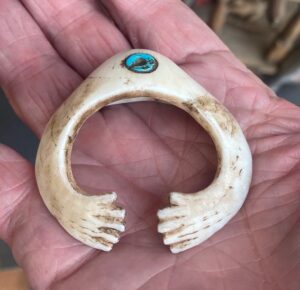
- #1366, An Early Pueblo Spiny Oyster Shell With a Turquoise Drop
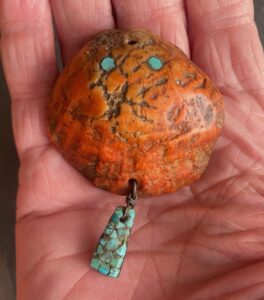
- #1283, Santo Domingo Shell Necklace and Chain
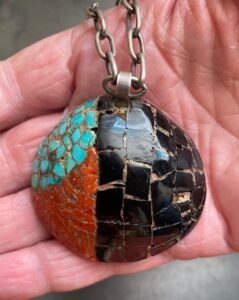
- #260, Santo Domingo Large Shell Necklace With Mosaic Turquoise and Abalone.
